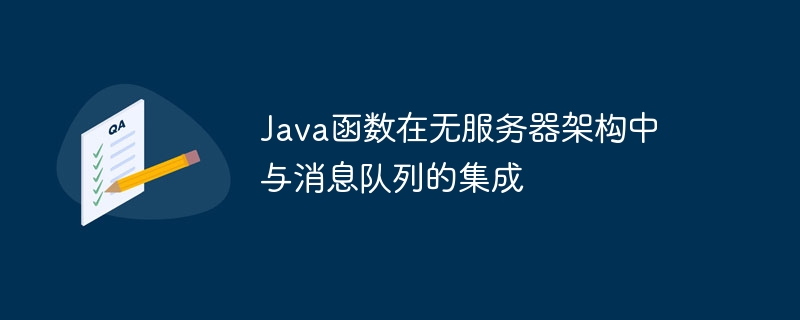Home >Java >javaTutorial >Integration of Java functions with message queues in serverless architecture
Integration of Java functions with message queues in serverless architecture
- WBOYOriginal
- 2024-04-26 17:15:02479browse
Integrating Java functions and message queues in serverless architecture enables: Asynchronous processing: Improves performance and scalability. Reliable messaging: Ensure reliable delivery of messages. Decoupled: Allows independent deployment and scaling. Practical example: AWS Lambda and SQS: Lambda function processes SQS messages. Create an Amazon SQS queue. Deploy Lambda functions to monitor SQS queues and process new messages.

Integration of Java functions and message queues in serverless architecture
Serverless architecture is a cloud computing model that Allows developers to build and deploy applications without a server. This provides multiple benefits, including resiliency, scalability, and cost optimization.
Integrating Java functions and message queues in a serverless architecture enables the following benefits:
- Asynchronous processing: Message queues allow you to decouple tasks into smaller Small, self-contained units. This allows you to process tasks asynchronously, improving the performance and scalability of your application.
- Reliable message delivery: The message queue provides a reliable message delivery mechanism to ensure that messages can be delivered reliably even in the event of system failure.
- Decoupling: Java functions and message queues are loosely coupled, allowing them to be deployed and expanded independently.
Practical Case: Using AWS Lambda and Amazon SQS
The following is an integration in a serverless environment using AWS Lambda and Amazon Simple Queue Service (SQS) Practical example of Java functions and message queues:
// 处理 SQS 消息的 Lambda 函数
import com.amazonaws.services.lambda.runtime.Context;
import com.amazonaws.services.lambda.runtime.RequestHandler;
import com.amazonaws.services.lambda.runtime.events.SQSEvent;
import com.amazonaws.services.lambda.runtime.events.SQSEvent.SQSMessage;
public class MessageQueueHandler
implements RequestHandler<SQSEvent, String> {
@Override
public String handleRequest(SQSEvent event, Context context) {
// 从 SQS 消息中提取消息体
SQSMessage message = event.getRecords().get(0);
String messageBody = message.getBody();
// 处理消息体并返回结果
return "Processed message: " + messageBody;
}
}# 创建 Amazon SQS 队列
aws sqs create-queue \
--queue-name my-queue \
--region us-east-1
# 部署 Lambda 函数
aws lambda create-function \
--function-name my-function \
--runtime java8.al2 \
--handler MessageQueueHandler \
--role arn:aws:iam::ACCOUNT_ID:role/lambda-basic-execution-role \
--code S3Bucket=my-bucket,S3Key=my-function.zip \
--environment Variables={QUEUE_URL=arn:aws:sqs:REGION:ACCOUNT_ID:my-queue} In this example, the MessageQueueHandler Lambda function handles messages received from an Amazon SQS queue. When a Lambda function is deployed, it automatically monitors the SQS queue for new messages. Once a new message is detected, the Lambda function calls the handleRequest method, extracts the message body and processes it.
The above is the detailed content of Integration of Java functions with message queues in serverless architecture. For more information, please follow other related articles on the PHP Chinese website!

